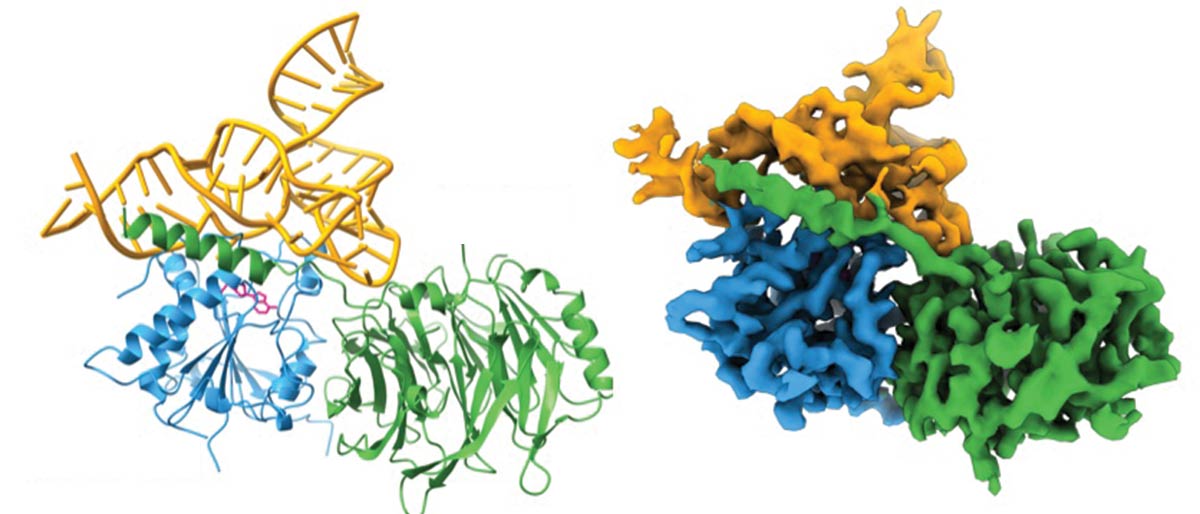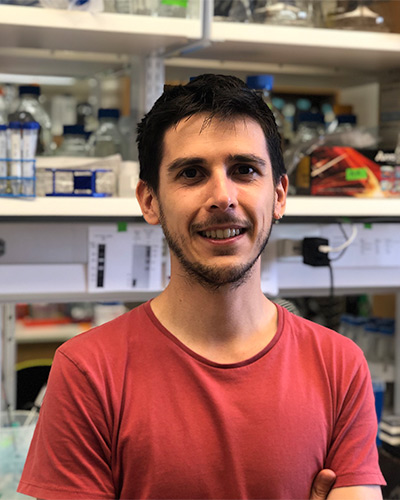Checks and balances
Research reveals rare view of enzyme involved in common cancers

UT Southwestern scientists have used cutting-edge technologies to obtain rare in-action views of a human enzyme involved in several common tumors, including those of the lung and liver.
“Using X-ray crystallography and cryo-electron microscopy (cryo-EM), we revealed at near-atomic resolution several 3D views indicating how a protein called METTL1 binds to its partner protein, WDR4, to form the METTL1/WDR4 enzyme complex that’s important for keeping protein levels balanced within cells,” said the Nature study’s corresponding author Yunsun Nam, Ph.D., Associate Professor of Biochemistry, Biophysics, and a member of the Harold C. Simmons Comprehensive Cancer Center. “Importantly, we’ve elucidated the molecular mechanisms underlying how the protein METTL1 (methyltransferase-like 1) adds a chemical modification – methylation – to tRNAs (transfer RNAs).”
UTSW research reveals rare view of enzyme involved in cancers
Dr. Nam explained that tRNAs are central to the process by which genetic information is “translated” to synthesize various proteins that are the workhorses of a cell. Chemical changes that add small molecules such as methyl groups to tRNAs govern how fast and how much protein to synthesize, she said. A certain rate of protein translation is necessary to maintain health while cancer cells prefer high levels of protein and unlimited growth.

Although it’s been known that METTL1/WDR4 is involved in adding modifications to tRNAs, the lack of a 3D model has hindered a deeper understanding of the enzyme complex. The study determined the site where the two proteins bind to form the complex and showed how they find the exact atomic location to attach a methyl group on the correct tRNAs. The study also describes a regulatory handle that can be used by upstream protein factors to control METTL1 activity and, ultimately, rates of protein synthesis.
“This work builds on our previous research that focused on abnormal modifications on messenger RNAs and how they contribute to cancer,” she said. “This new project shows how tRNA modifications need to be exquisitely controlled for normal cellular function and how abnormally low or high rates of modification lead to disease.
“Transfer RNAs are basic constituents of the central dogma of life through their role in protein synthesis. Chemical modifications, including methylation, control tRNA function by altering its stability, half-life, and/or specificity. For example, a modified tRNA can decode the genetic information differently or increase in amount to produce certain proteins more efficiently,” Dr. Nam added. “Cancers sometimes hijack the modification system to steer tRNAs toward uncontrolled growth. Our work provides new avenues to target unwanted methylation of tRNAs for cancers that are addicted to uncontrolled protein synthesis to fuel tumor growth.”
Knowing how METTL1 works at the atomic level opens up opportunities to target it specifically and effectively, she said.

The work was led by UTSW postdoctoral researcher Victor Ruiz-Arroyo, Ph.D., and other researchers in the Nam lab. Other UTSW co-authors include Kesavan Babu, Ph.D., a senior research associate, and Rishi Raj, Ph.D., a former Nam lab postdoctoral researcher.
The team also received valuable help from Cryo-Electron Microscopy Facility (CEMF) and Structural Biology Lab (SBL) groups at UTSW, Dr. Nam added. “The state-of-the-art cryo-EM equipment allowed us to get high-quality data to visualize the METTL1/WDR4 complex in action. Our access to the shared high-throughput screening core facility at UTSW, equipped with the RapidFire mass spectrometry technology, was also helpful for biochemical characterization of the RNA modification enzyme required for the structural biology,” she said.
This work was supported by the National Institutes of Health (R01GM122960 and R01CA258589), the Cancer Prevention and Research Institute of Texas (RP190259), and The Welch Foundation (I-2115-20220331).
Dr. Nam is a Southwestern Medical Foundation Scholar in Biomedical Research.

